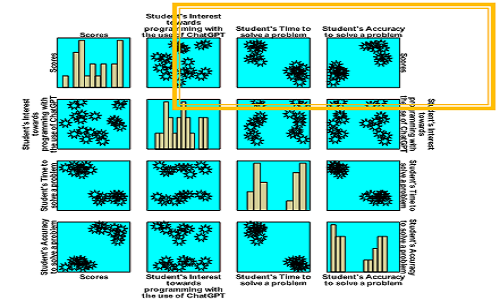
Impact of AI-ChatGPT Intervention on Coding: NPL Supportive Approach to Teaching and Learning Effectiveness
Abstract
Keywords
Full Text:
PDFReferences
Afinda, B. N., Anwar, S., & Sumarna, O. (2023). Analysis of The Need for Applied Science Teaching Materials in Chemical Materials in Vocational School, Department of Culinary, Tangerang District. Journal of Education and Learning Research, 1(1), 30-36.
Ahmad, S. F., Rahmat, M. K., Mubarik, M. S., Alam, M. M., & Hyder, S. I. (2021). Artificial Intelligence and Its Role in Education. Sustainability, 13(1), 12902. https://doi.org/10.3390/%20su132212902
Avijeet, B. (2023). AI application: Top 18 Artificial Intelligence Applications in 2023. Simplilearn.com. https://simplilearn.com
Cheguri, P. (2023). Top 10 uses of ChatGPT for Python Programmers. Simplilearn.com. https://simplilearn.com
Holmes, W., Persson, J., Chounta, I.-A., Wasson, B., & Dimitrova, V. (2022). Artificial Intelligence and Education: A Critical View Through the Lens of Human Rights, Democracy and the Rule of Law. Council of Europe.
IndustryTrends. (2023). Edpuzzle: Online Free Tools for Teachers. Edpuzzle. https://edpuzzle.com
Jia, F., Sun, D., Ma, Q., & Looi, C. K. (2022). Developing An Ai-Based Learning System for l2 Learners’ Authentic and Ubiquitous Learning in English Language. Sustainability, 14(1), 15527. https://doi.org/10.3390/su142315527
Lumen. (2023). 10 Benefits & Uses for Technology in Classroom. Lumenlearning. https://lumenlearning.com/technology-in-the-classroom/
Miao & Holmes. (2021). AI and Education Guidance for Policy-Makers. Unesdoc-Unuesco. https://unesdoc-unuesco.org/ark:/48223/pf0000376709
Mieczyslaw , L. O., Agnieszka, S., & Paweł , W. (2021). Artificial Intelligence Technologies in Education: Benefits, Challenges and Strategies of Implementation. Researchgate. https://researchgate.net
Muraina, I. O., Adeleke, I. A., & Rahman, M. A. (2011). Computer Assisted Instruction for Teaching / Learning Process And Its Effects on Students’ Performance in Tertiary Institutions. International Journal of Computer Trends and Technology, 2(1), 15–19. http://ijcttjournal.org/archives/ijctt-v2i1p104
Sari, I. P., Sormin, R. K., Purba, A., Rahayu, A. P., & Khairas, E. E. (2023). Effectiveness of Flash Card Media to Improve Early Childhood English Letter and Vocabulary Recognition in Reading. Journal of Education and Learning Research, 1(1), 1-7.
Seldon, A., & Abidoye, O. (2018). The Fourth Education Revolution: Will Artificial Intelligence Librate or Infantilise Humanity? (p.370). Buckingham, University of Buckingham.
Sumakul, D. T., Hamied, F. A., & Sukyadi, D. (2022). Artificial Intelligence in EFL Classrooms: Friend or foe? LEARN Journal: Language Education and Acquisition Research Network, 15(1), 232–256.
Verma, M. (2018). Artificial Intelligence and its Scope in Different Areas with Special Reference to the Field of Education. International Journal of Advanced Educational Research, 3(1), 5–10.
Vorst, T. van der , & Jelicic, N. (2019). Artificial Intelligence in Education: Can AI Bring the Full Potential of Personalized Learning to Education? Towaeds A Connected and Automated Society. 30th European Conference of the International Telecommunications Society (ITS), Helsinki, Finland, 16th-19th June 2019.
Woolf, B. P. (2021). AI and Education: Celebrating 30 Years of Marriage. AIED 2015 Workshop Proceedings, 4, 38–47.
Xu, Z., Wei, Y., & Zhang, J. (2021). AI Applications in Education. In Artificial Intelligence for Communications and Networks: Second EAI International Conference, AICON 2020, Virtual Event, December 19-20, 2020, Proceedings 2 (pp. 326-339). Springer International Publishing.
Zawacki-Richter, O., Marin, V. I., & Bond, M. (2019). Systematic Review of Research on Artificial Intelligence Application in Higher Education -Where are the Education? International Journal Education Technology for Higher Education, 16(39).
Zhai, X. (2022). ChatGPT User Experience: Implications for Education. Researchgate. https://researchgate.net
DOI: http://dx.doi.org/10.31258/jes.8.3.p.312-324
Refbacks
- There are currently no refbacks.
Copyright (c) 2024 Ismail Olaniyi MURAINA

This work is licensed under a Creative Commons Attribution 4.0 International License.
Publisher: FKIP Universitas Riau













